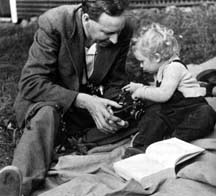Gregory Bateson with his daughter,
Mary Catherine.

Gregory Bateson came from a distinguished line of English academics. His father, William, was one of the founders of modern genetics. His paternal grandfather, William Henry Bateson, had been the Master of St. John's, the Cambridge college in which Gregory matriculated, receiving his bachelor's degree (in natural sciences) in 1925 and his master's (in anthropology) in 1930 after a brief study under A. C. Haddon and field research in New Britain and New Guinea.
Little came from his first fieldwork among the Baining and Sulka people of New Britain, but the classicNaven(1936, 2nd ed. 1965) was the result of his work among the Iatmul, which began in 1929 and continued into the 1930s. His reputation in anthropology still rests to a considerable degree on this first book. Later, in the 1930s, he collaborated in field research in Bali with Margaret Mead, reported inBalinese Character(1942). In the 1940s and 1950s he brought his ethnographic method to bear on schizophrenia and other psychiatric phenomena (notably, disturbed communication within families) to considerable theoretical effect, and
 he also did research on the behavior of other species: sea otters and octopuses, and most importantly, porpoises. This work resulted inCommunication: The Social Matrix of Psychiatry(1951), written with the psychiatrist Jurgen Ruesch; inPerceval's Narrative(1961), and in some of the items in his collected papers,Steps to an Ecology of Mind(1972). If the subjects of his research seem disparate, the list of topics over which he ranged seems even more so: biological evolution, adaptation, ecology, art, arms races, social organization, communication, cultural transmission, learning, play, fantasy, films, character and personality, and, more generally, the nature and pathologies of thinking and epistemology, of culture, and of a great class of integrative processes which he eventually called "mind." But he dealt with these phenomena in terms of a coherent and increasingly integrated set of highly abstract concepts influenced mostly by theories of communication and by cybernetics.
he also did research on the behavior of other species: sea otters and octopuses, and most importantly, porpoises. This work resulted inCommunication: The Social Matrix of Psychiatry(1951), written with the psychiatrist Jurgen Ruesch; inPerceval's Narrative(1961), and in some of the items in his collected papers,Steps to an Ecology of Mind(1972). If the subjects of his research seem disparate, the list of topics over which he ranged seems even more so: biological evolution, adaptation, ecology, art, arms races, social organization, communication, cultural transmission, learning, play, fantasy, films, character and personality, and, more generally, the nature and pathologies of thinking and epistemology, of culture, and of a great class of integrative processes which he eventually called "mind." But he dealt with these phenomena in terms of a coherent and increasingly integrated set of highly abstract concepts influenced mostly by theories of communication and by cybernetics.Bateson never held a regular position in an academic department of anthropology. He was a fellow at St. Johns, Cambridge University, from 1931 until 1937, but spent a good deal of that period in New Guinea and the United States. He entered the United States as a permanent resident in 1940, and served in Asia in the O. S. S. during World War II. In the late 1940s, he held visiting appointments at the New School for Social Research and Harvard; later he held visiting appointments at Stanford, the University of Hawaii, and the University of California, Santa Cruz. His regular employment during much of his career was in medical institutions and laboratories for the study of animal behavior. Moreover, with the possible exception of a time during the late 1930s and 1940s, when concern with the relationship of culture to character and personality was more general than it has been since, he never stood near the center of contemporary anthropological interests. Although a general anthropological audience came to appreciateNavenin the late 1950s and the 1960s (25 years after its original publication), and althoughSteps to an Ecology of Mindmade many of his essays published in obscure journals available to anthropologists and revealed to some readers new anthropological and intellectual horizons, he remained a deeply puzzling figure to a good many of his colleagues until the end of his life. His style, his concerns, his method, and his moral position all served to polarize his intellectual audience and, to a large degree, to make the enthusiasts and the skeptical puzzled about each other's responses. We wish to consider here some of the roots of the puzzlement.


 正在提交中...
正在提交中...



